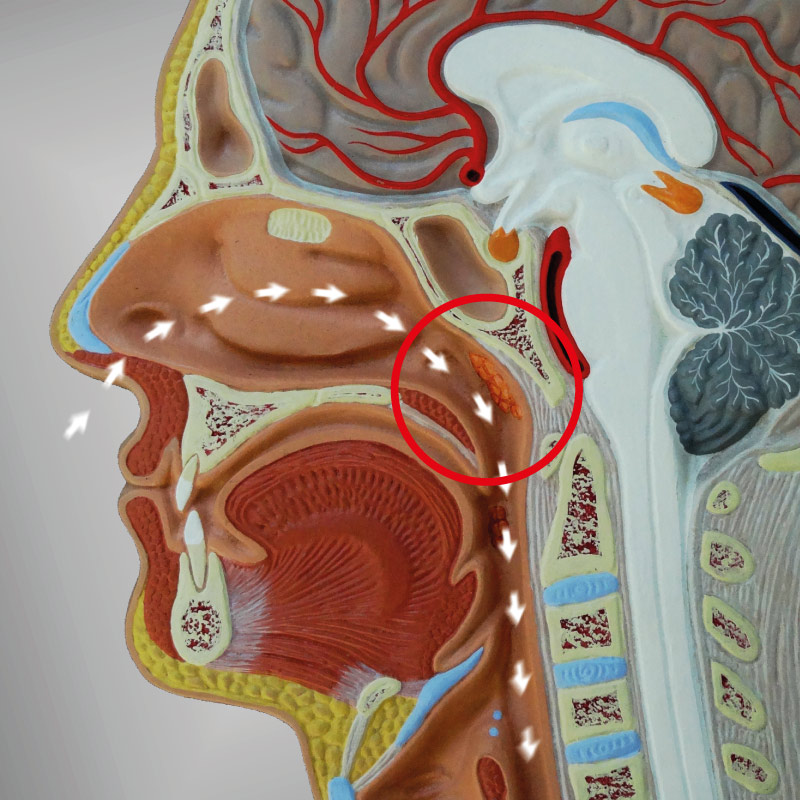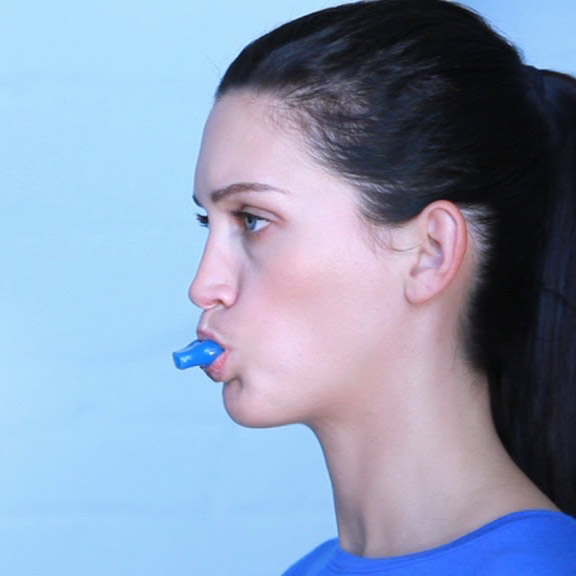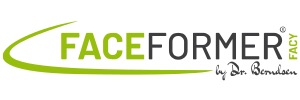Nasal polyps and adenoid hypertrophy
Natural prevention through nasal breathing training
Natural prevention through nasal breathing training
Nasal polyps and adenoid hypertropy are health problems that are common, especially in children, and can affect their everyday well-being. In this article, we shed light on this clinical picture to provide an in-depth understanding of the causes, the effects and, most importantly, the natural prevention methods. The aim is not only to improve the quality of life of our children, but also to make an active contribution to prevention. Through effective awareness and the application of simple breathing techniques, we can take a significant step towards improving the health of our children.
Adenoid vegetations are an enlargement of the adenoids, also called the pharyngeal tonsils. The adenoids are a soft mass of tissue at the back of the nasal cavity that is designed to ward off infections by acting as a kind of barrier or filter to trap bacteria and viruses that enter through the nose or mouth. In children, the adenoids can enlarge and grow into the nostrils, causing difficulty breathing through the nose. This condition is most common in children because the adenoids normally shrink after puberty.
Nasal polyps, on the other hand, are soft, painless, non-cancerous growths on the lining of the nasal passages or sinuses. They hang down like dewdrops and often develop in the course of chronic inflammation, asthma, recurrent infections or allergies. They can vary in size and spread to both nostrils, obstructing breathing and reducing the sense of smell. In advanced stages, they can cause sleep disturbances and chronic sinusitis.
Excessive mouth breathing is often a sign that nasal polyps or adenoid enlargement are obstructing nasal breathing. It is important to note that although mouth breathing may be an immediate solution to acute breathing problems, it is harmful in the long run. It can lead to the spread of infections and affects children’s posture, speech and even facial growth. Therefore, it is important to understand the causes of mouth breathing and look for ways to minimise it and promote natural nasal breathing.


Normally formed adenoids do not cause any discomfort. Enlarged adenoids, on the other hand, which can spread far into the nasal cavity, severely obstruct nasal breathing. Numerous health problems due to predominant mouth breathing result from this.
The restriction or obstruction of nasal breathing due to enlarged adenoids or nasal polyps and the resulting switch to mouth breathing can lead to a number of health problems. These include:
Mouth breathing bypasses the natural barrier function of the nose, which can lead to more frequent respiratory infections.
Adenoid vegetations and nasal polyps can cause the Eustachian tube (the connecting channel between the middle ear and the nasopharynx) to become blocked. This can increase the risk of middle ear infections and, if prolonged, can lead to permanent hearing problems and even hearing loss. In addition, disturbed ventilation of the middle ear can lead to a so-called tympanic effusion, where fluid accumulates in the middle ear. This can also affect hearing and lead to speech and learning problems in children.
Chronic mouth breathing, especially during the growth phase, can lead to changes in the facial and jaw area. These include an elongated face, a protruding upper jaw and an unfavourable tongue position that can lead to malpositioned teeth.
The altered breathing and the associated anatomical changes can lead to voice and speech problems.
Impaired nasal breathing can lead to sleep apnoea and other sleep disorders, which in turn can cause daytime sleepiness, concentration difficulties and school problems in children.
Sleep disturbances and a reduced quality of life due to chronic mouth breathing can lead to psychological problems such as anxiety or depression in children.
Impaired nasal breathing can reduce oxygen supply during physical activity and thus limit athletic performance.
The exact causes for the growth of nasal polyps are not fully understood, but chronic inflammation in the nose plays a central role. There are several conditions that can lead to chronic inflammation, including allergic reactions, asthma, repeated respiratory infections and certain immune diseases.
Mouth breathing is another factor that can promote polyp growth. When the nose is not used regularly for breathing – for example, when the nose is blocked – this can lead to changes in the nasal passages. This is because the constant ventilation of the nose through breathing has a certain “cleansing effect” – it helps to keep the mucous membranes moist and clean and to remove bacteria and viruses. When this function is impaired, conditions in the nasal passages can change, which can promote the growth of polyps.
Nasal polyps grow mainly in the paranasal sinuses and can slowly grow from there into the main nasal cavity.
In addition, switching from nasal breathing to mouth breathing can bypass the protective function of the nose and cause children to become sick more often by bypassing the filtering and moisture-regulating functions of the nose. If these conditions persist, they can increase inflammation of the nasal mucosa and even promote the growth of polyps.
It is also important to know that proliferation of adenoids – the adenoids of the throat – can contribute to nasal congestion, especially in children. These adenoids can enlarge as a result of infection and cause children to breathe through the mouth, which in turn can promote polyp growth.
It is a complex process with several factors at play, but it is clear that avoiding mouth breathing and promoting nasal breathing are key strategies in preventing the growth of nasal polyps early on.
Treatment for nasal polyps and adenoid growths often initially relies on drug therapy, especially when symptoms are mild. Thus, medications such as nasal sprays, antihistamines, or corticosteroids are used to relieve symptoms, reduce swelling, and facilitate breathing.
In more severe cases or if medication is unsuccessful, surgery to remove the polyps or adenoids may be considered. These surgeries are usually performed to improve nasal breathing and reduce repeated infections.
Keep in mind that while surgery can remove existing polyps, it will not necessarily prevent them from recurring in the future. This brings us to aftercare and the problems that can occur after surgery to remove nasal polyps.
After surgery to remove nasal polyps, the child may initially experience relief as the blocked nose becomes unblocked. However, the child may continue to breathe through the mouth despite the opened nose because he or she is used to this type of breathing. This can be a problem because mouth breathing can encourage the polyps to grow again.
In addition, if the adenoids are not completely removed, they can grow again and block the nose again. This is because the adenoids are like a small tree that keeps sprouting branches (the polyps). If you cut off the “little tree” at the bottom, it can sprout new branches again, which can then grow into the nose and block it.
For these reasons, it is important to follow up appropriately after surgery to remove nasal polyps and develop strategies to improve nasal breathing. This can be achieved through various exercises and methods to promote nasal breathing and reduce mouth breathing. This will be discussed in more detail in the next section.
Proper nasal breathing plays a critical role in health and overall well-being. Breathing through the nose has several advantages over mouth breathing. First, the nose acts as a filter, removing pollutants and microorganisms from the air we breathe. Second, the nose warms and humidifies the air before it enters the lungs, which helps keep the respiratory system healthy. Finally, nasal breathing promotes the production of nitric oxide, a molecule that improves lung function and supports the immune system.
However, inadequate nasal breathing or a habit of mouth breathing can contribute to the development of nasal polyps. As we mentioned earlier, nasal polyps and adenoid growths can grow when the nose is not used adequately. This is because the constant movement of air through the nose during inhalation and exhalation creates a certain “headwind” that prevents the growth of adenoid tissue in the nasal passages.
Regular FaceFormer training promotes nasal breathing.
Therefore, it is important to train and promote nasal breathing, especially after surgery to remove nasal polyps. One proven method to improve nasal breathing is FaceFormer Training.
FaceFormer Training is a special exercise program designed to strengthen the muscles of the face, mouth and throat. At the same time the exercises promote proper breathing through and reduce mouth breathing. FaceFormer exercises contribute to correct posture and reduce the risk of infections and colds, which are more common in children who breathe through the mouth. Regular training with the FaceFormer and the resulting behavioral changes lead to the formation of new neural patterns in the brain. This is based on the principle of neuroplasticity – the ability of our brain to adapt to new behaviors and form new connections. Thus, natural nasal breathing becomes the predominant form of breathing and replaces harmful mouth breathing, resulting in healthier and more efficient breathing.
By promoting and practicing proper nasal breathing, you can reduce the risk of developing nasal polyps and help keep your nose clear and healthy.

Nasal polyps and adenoid growths are conditions that can significantly impair nasal breathing and severely affect the well-being of children. They are caused by a variety of factors, including chronic inflammation, allergic reactions, and repeated infections. Oral breathing plays an important role, bypassing the natural cleansing function of the nose and promoting the development of polyps.
While medications and surgery can be effective treatments in some cases, preventing nasal polyps by promoting nasal breathing is a critical step in preventing the condition. It is especially important to teach children to breathe through the nose and minimize mouth breathing. FaceFormer training is a valuable way to train and encourage nasal breathing. Regular use of these exercises can promote proper breathing, change neural patterns, and reduce the risk of developing nasal polyps.
The ultimate goal is to improve children’s health and well-being by teaching them to take advantage of nasal breathing and avoid the negative effects of mouth breathing. This is a simple but effective strategy that can help prevent the development of nasal polyps and adenoid hypertrophy. Prevention is better than cure.
You can purchase your FaceFormer online in the Dr. Berndsen Shop, from our sales partners or from numerous doctors and therapists or locally in your pharmacy.
Ask for the central pharmaceutical number PZN 18092273 (FaceFormer ONE blue).
Further product variants and useful accessories are available.
Saving tip especially for doctors and therapists: 20%++ discount on orders of 5 FaceFormers or more!
The effective solution for snoring, sleep apnea, CMD, jaw problems and many other indications. Simple, causal, effective.
Der FaceFormer ONE Der FaceFormer, ein Medizinprodukt der Klasse 1, ist aus medizinischem Elastosil gefertigt und garantiert schadstofffrei. Die Therapie zielt darauf ab, fehlerhafte Funktionsabläufe zu korrigieren, die verschiedene Symptome beeinflussen können. Seit zwei Jahrzehnten stellt die FaceFormer-Therapie eine…
Die FaceFormer® Therapie: Der FaceFormer, ein Medizinprodukt der Klasse 1, ist aus medizinischem Elastosil gefertigt und garantiert schadstofffrei. Die Therapie zielt darauf ab, fehlerhafte Funktionsabläufe zu korrigieren, die verschiedene Symptome beeinflussen können. Seit zwei Jahrzehnten stellt die FaceFormer-Therap…
Der neue FaceFormer® ZERO Auf vielfachen Anwenderwunsch hat die FaceFormer Familie Zuwachs bekommen. Zusätzlich zum bekannten FaceFormer ONE in blau oder kristallklar ist ab sofort der FaceFormer ZERO erhältlich. Was ist anders? Der FaceFormer ZERO weist eine geringere Materialhärte auf, als die bisherigen Modelle. Grö…
FaceFormer® ZERO & ONE Therapie-Set für Erwachsene Überblick: Dieses Therapie-Set umfasst die Modelle FaceFormer ZERO und FaceFormer ONE. Beide sind als medizinische Geräte der Klasse 1 aus medizinischem Elastosil® hergestellt und sind BPA-frei sowie frei von flüchtigen Stoffen. Sie sind speziell darauf ausgelegt, die …
Wasserstr.25
59423 Unna
Germany
+49 (0) 23 03-89 99 1
+49 (0) 23 03 – 89 88 6
Mo. to Fr. from 8:00 to 16:00

 The power of the vagus nerve – activating the body’s own self-healing...
The power of the vagus nerve – activating the body’s own self-healing...This site uses cookies. By continuing to browse the site, you are agreeing to our use of cookies.
OK, agree with allAgree to essentialsShow settingsThe satisfaction of visitors to our website is important to us. In order to better address you, we use cookies. Thereby we achieve that the website works technically reliable and secure.
You can change or revoke your consent at any time.
In the privacy policy you can learn more about cookies and privacy setting.
View privacy policy
Essential cookies enable basic functionality and are necessary for the proper functioning of the website.
This data may be linked to user information of users logged in on youtube.com and google.com.
YouTube video embedding
Used to unlock YouTube content.
Google Analytics
Cookie from Google for website analytics.
Generates statistical data about how the visitor uses the website
